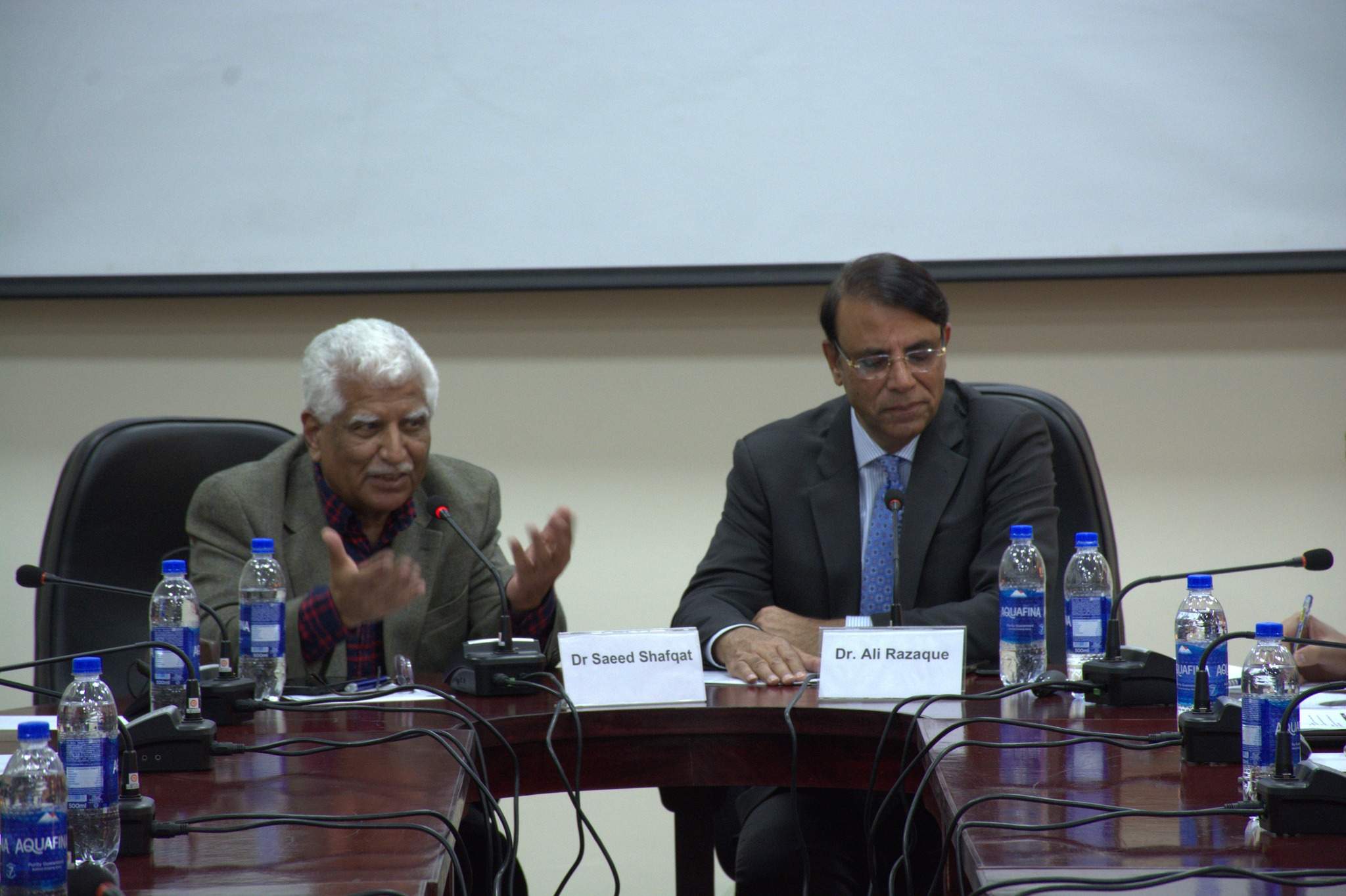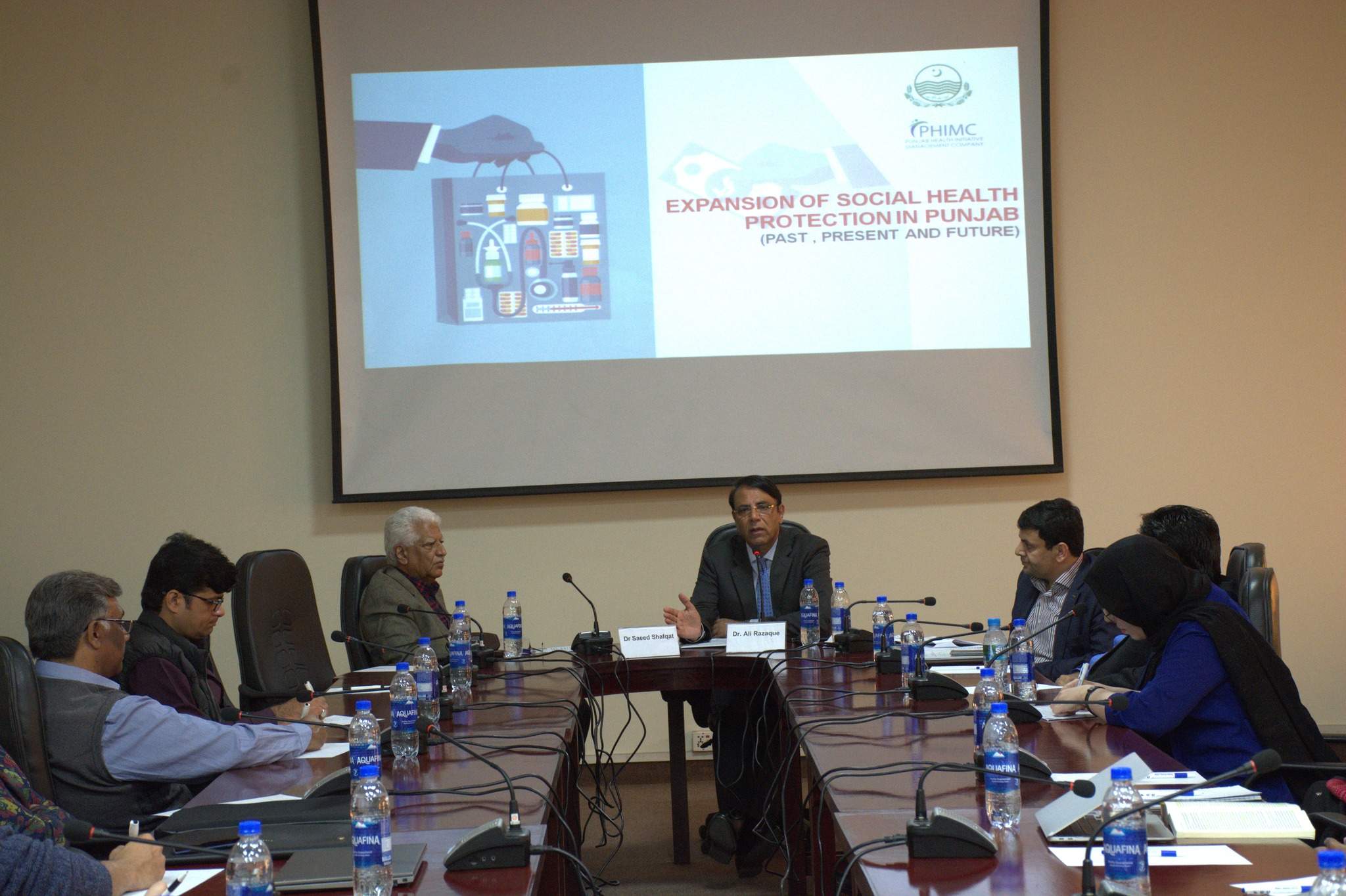
Universal Health Insurance in Punjab: Understanding the Sehat Sahulat Program
Seminar
Past Event
Dec 12, 2022 - 5:00 pm |
Dec 12, 2022 - 7:00 pm
Ali Razzaq, CEO of PHIMC (Punjab Health Initiative Management Company)
FCC Lahore
Upcoming Event
On December 12th, Dr. Ali Razzaq, CEO of Punjab Health Initiative Management Company (PHIMC), was invited to deliver a seminar for International Day for Universal Health Coverage at the Centre for Public Policy and Governance. Dr. Ali was joined by his colleagues from PHIMC Mr. Munib Ahmed and Mr.Hasnat Ahmed. The seminar was moderated by Dr. Saeed Shafqat, Professor and Founding Director, CPPG. Students and faculty members participated in the event with great zest and zeal.
Dr. Ali Razzaque holds a master’s degree in Health Planning and Financing from London School of Economics and Political Science. He has also completed an Executive Program from Harvard University in Managing Health Programs in developing countries. He is currently serving as the Chief Executive Officer at PHIMC. The Punjab Health Initiative Management Company is a Lahore based government section 42 company. The goal of the PHIMC is to advance health justice and strengthen public health through innovation and partnerships with the private sector to provide universal health coverage. Following the principles of Universal Health Coverage, the PHIMC took the initiative to introduce and launch a Universal Health Insurance strategy to facilitate the poor and underprivileged people of the Punjab under the Sehat Sahulat Program.
Dr. Ali began by giving a brief overview of the universal health insurance program in Punjab. Launched, in 2016, the essence of the program was to provide free services to the vulnerable, poor and underprivileged population of the province. They started off by providing healthcare services to 4 districts in 2017, and by 2022, have covered almost all 36 districts of Punjab. While initially the program covered financially vulnerable households, now all of the province’s households are covered. He further added that this was a brain child of the ex-Prime Minister of Pakistan, Mr. Imran Khan to provide the UHI to the marginalized. The data related to the demography of the people has been collected with the help of Benazir Income Support Program. Up until now, the program has covered 7 million people including transgenders and people with disabilities. Under this program, people from every division of the Punjab are eligible to access to free treatment for up to 1 million—this number can be increased depending on individual circumstances. More than 800 hospitals—204 public sector hospitals and 610 private sector hospitals—facilitate patients from across Punjab.
Moving forward, he said that private sector hospitals like Doctors Hospital, Hameed Lateef and Omer Hospital are paneled hospitals. But they have been paneled for cardiac diseases. There is a great workload in terms of managing finances on cardiac patients. Given the fact that overcrowded places like Punjab Institute of Cardiology Lahore cannot cater for all the population of Lahore due to the scarcity of resources, the patients turn to private sector hospitals. As estimated, more than 75% of patients prefer to visit private hospitals to seek better healthcare facilities. As far as the public sector is concerned, the Initiative is urging the Chief Minister and relevant health department to generate resources since the program covers the premium of more than 31 million families in Punjab to the public sector hospitals. He added that State Life Insurance is the implementing partner of PMIHC.
Moreover, people can avail health facilities only by using their CNIC to seek the benefit from the Sehat Sahulat Program. One challenge that remains for the program is to ensure households are keeping their family tree updated on NADRA records. It is unfortunate that people lose out on services if they are records are not updated. For instance, once an individual gets married, their household classification changes and he/she needs to ensure this change is registered with NADRA. It is equally important to mention that the Sehat Sahulat Program defines a unit of family as husband, wife and unmarried children.
Addressing the question about the health budget of the Sehat Sahulat Program for Punjab, he said that the program allocated a budget of PKR 468 million. Besides, out of 112 million people who are currently seeking the benefits of this program, 51% are men, 49% women and 43% are children. He also provided statistics about the infrastructure of the health institutions (Figure 1). In the same breath, all the hospitals under the jurisdiction of PHIMC, have 15,000 indoor admissions, 36,000 emergency departments, 390,000 outpatient departments, and 100,000 outreach services.
| BHUs AND RHCs | 2818 |
| DHQs AND THQs | 149 |
| Tertiary Hospitals | 48 |
| Overall Beds in all hospitals | 55000 |
Figure 1.
Dr. Ali continued by providing a brief account of the benefits of the Sehat Sahulat Program: a fixed premium (PKR 4,300) has been paid for every beneficiary family to the insurance company [State Life Insurance], all permanent residents registered with NADRA are eligible to avail services under this program.
He shed light on the priority, secondary care and ailments, as well as the reserve funds of the Sehat Program. The program allocates PKR 400,000, with an additional 200,000 per family for a year. By the same token, the secondary care covers up to 60,000, with an additional 40,000. Needless to say, the government is responsible for managing all the finances related to the budgeting of this program. The priority and secondary care ailments are enlisted in the table below.
| Priority Care | Secondary Care | Reserved Fund |
| Cardiac Surgery & Cardiology | Medical and Surgical Procedures | Special claims provision |
| Oncology | Maternity care and planning | Decision of Government |
| Burns, Trauma, Accidents | Post abortive care package | Funding by Government |
| Diabetes Complications | Blood transfusion for admitted patient | |
| Neurosurgery | ||
| Rheumatology/Ortho | ||
| Renal Transplant | ||
| Corrective placement for disabled |
Figure 1. Priority and Secondary Ailments
Talking about the way forward, Dr. Ali mentioned that their aim is to address various challenges the program is facing such as parallel funding, double dipping (households using several insurance programs at the same time), quality assurance, impact of inflation on costs, lack of availability of standard treatment protocols and under-utilization of SSP in public sector hospitals. He elucidated that remodeling of healthcare and financing to avoid duplication of benefits, performance based financing, and strategic purchasing to are crucial to align the healthcare financing to achieve “more health for the money.”
Ending the session, a number of questions were asked by the participants. There was discussion about the sustainability of the program and the likelihood that financially stronger households may crowd out resources due to their awareness and greater accessibility to health services. The PHIMC team responded that sustainability of the program depends on financial sustainability. So far no international donor has contributed to the program, it is run entirely from the Punjab budget however to ensure the program continues, we will need continued political commitment as well as an allocation of budgets that secure the financial model behind the program. Moreover, universal health coverage entitles all income groups to avail health services but our aim is to ensure the most vulnerable gain easy access. This means working harder on effective awareness and marketing campaigns. There was also discussion on the need to focus on preventative care rather than focusing all attention on treatment. From the quality of crops and nutrition, to waste management and urban cleanliness, the Sehat Sahulat Program must be integrated to with other development programs that emphasize various forms of health preparedness and preventative measures—to which the PHIMC team agreed and added that whilst this is important, the burden of disease is so high in Punjab that even focusing on tertiary care will help long term development objectives. In addition to questions, some brilliant ideas were put forward by the students of CPPG to face the challenges related to the Sehat Program for instance using the Nikah Nahma registration to quantify and update data on the number of new family units being created.




